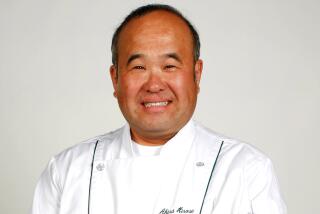Ichimura Uzaemon; Icon of Kabuki Theater
- Share via
TOKYO — Ichimura Uzaemon, a Kabuki icon with encyclopedic knowledge of theater tradition, died Sunday at the age 84 of complications from lung cancer.
“He is the last heavyweight in the Kabuki world,” said theater critic Katsuyo Ito. “He learned directly from the old, legendary actors. He was such an important person in the community.”
Like many actors in the close-knit profession, Uzaemon was born into the job, the seventh generation of a family of Kabuki artists. He also passed on his passion: All three of his sons followed him onto the stage.
Uzaemon was born Mamoru Bando in 1916 in Tokyo, but over the years acquired a series of stage names before being adopted into the renowned Uzaemon Kabuki family in 1955 and taking the identity Ichimura Uzaemon XVII.
Uzaemon had his stage debut at age 5, when he made a brief appearance at the Imperial Theater. Over the next three decades, he trained rigorously under his uncle, Kabuki legend Onoe Kikugoro, until the death of his mentor in 1949.
With Japan a shambles after the war, Uzaemon co-founded the Kikugoro theatrical company to help keep the old traditions alive.
In 1955, while keeping the Uzaemon name, he became head of the Tachibanaya Kabuki family--one of 22 established Kabuki families that trace their roots back centuries--a position he held until his death.
Uzaemon performed in many of Kabuki’s most famous plays, mostly in supporting roles but, toward the end of his career, also in some leading roles.
He was not an innovator and lacked the brilliance of other Kabuki icons, critics say. But over decades he perfected his art and gained a reputation for his keen insight into the old customs and methods. In 1990, the Japanese government designated him a “living national treasure.”
“He was not a star, but he supported stars,” said Toshio Kawatake, professor emeritus of theater studies at Waseda University. “He was a modest and steady person rather than a great creative force.”
Kabuki actors who worked with him say he had extremely high standards, a warm heart and an enormous love for the theater. “He was really strong-minded. There are few left like him,” fellow actor Nizaemon Kataoka said. “We are losing the great figures of that generation and must work hard to fill the vacuum.”
Among his more memorable performances were supporting roles in “Sukeroku”--a play in which the lead character commits suicide with a prostitute in an Osaka temple--and the lead role at age 74 in “Kanjincho”--one of Kabuki’s canonical works about a battle between two warlords.
Although Kabuki is a high art form today, it stems from humble roots. Kabuki, which literally means “to wear a strange costume,” reportedly started in 1603. That year, a self-proclaimed shrine maiden named Okuni traveled to Kyoto and performed a dance of ecstasy dressed in men’s clothing while chanting Buddha’s name.
The performance and the genre it sparked were quite provocative for their day. And because Okuni and many of the other original Kabuki actresses also were prostitutes, the military government decided in 1629 to ban all female Kabuki. To this day, all parts are performed by men.
Many Kabuki plays are about historical events and outdated social customs, but their underlying themes of love, heroism and betrayal are universal and guarantee a strong following, said theater critic Masako Numano. In recent years, Kabuki has adapted to the tastes of modern audiences with more dramatic staging and language that is easier to understand.
When Uzaemon was found to have lung cancer in the mid-1990s, he refused to let doctors remove his lung. He said he would rather live his remaining years as an actor with his voice intact than extend his life.
As his condition deteriorated, however, he underwent a series of operations starting in late 1998. But he kept performing until April of this year, when he finally collapsed while working at a theater in Osaka. On Sunday, he lost consciousness and died with his family at his side.
He is survived by his wife, Tamako, and his three sons.
*
/ Makiko Inoue of The Times’ Tokyo Bureau contributed to this story.
More to Read
The biggest entertainment stories
Get our big stories about Hollywood, film, television, music, arts, culture and more right in your inbox as soon as they publish.
You may occasionally receive promotional content from the Los Angeles Times.










